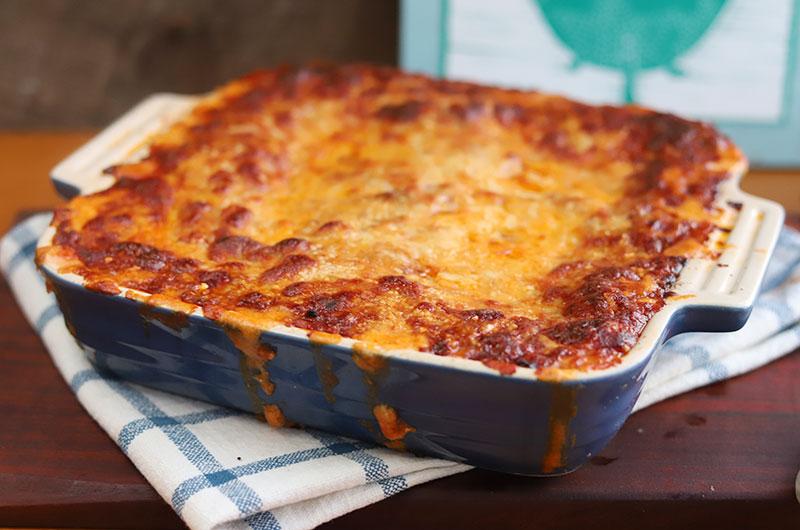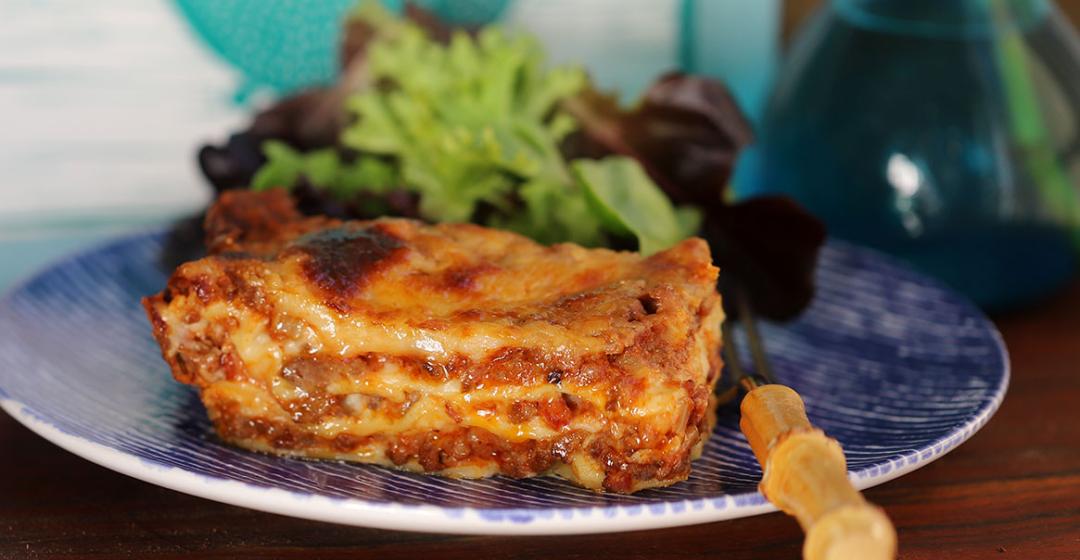I have a lot of strong feelings about lasagna. First and foremost, I freakin’ love it. I believe it can be the most comforting meal to eat and a deep expression of love to prepare. I’ve had versions with radicchio in Venice, ragù swapped out for pesto in Liguria, and lasagna studded with eggplant and fresh juicy tomatoes under the hot Sicilian sun. While I can get down with just about any well-made iteration of layered noodles, sauce, and cheese baked together in the oven, the one thing I will not budge on is the necessity of béchamel.
Béchamel (besciamella in Italian) is a thick white sauce made from milk, butter, and flour. It gives lasagna its signature rich, velvety texture that ties the whole dish together. In my opinion, substituting ricotta for béchamel (as is often done in American recipes but hardly ever in Italy) is the worst thing that can happen to lasagna. It makes it runny, grainy, and waters down the flavor. Making béchamel is not difficult, doesn’t require many ingredients, and is a technique that home cooks should have in their arsenals. It’s as simple as cooking butter and flour together and whisking in milk to create a thick, stable sauce. After mastering a basic béchamel, you can add all sorts of flavors and cheeses to give your sauce just the right personality. For this lasagna, all it needs is a touch of nutmeg and a healthy dose of grated Parmesan.
I based this recipe off a lasagna I made in culinary school in Emilia-Romagna a decade ago. While lasagna in this region of Italy is traditionally made with fresh spinach noodles, or lasagne agli spinaci, I made this recipe with the oven-ready lasagne noodles that don’t require boiling. The meat sauce has ground beef and cubed salami; you could use pancetta or another cured Italian meat in place of the salami (or omit it all together). It starts with a robust soffritto of onions, carrots, celery, and fresh fennel mixed with garlic and tomato paste and deglazed with white wine. The result is a meaty sauce with a touch of tomato (rather than tomato sauce accented by meat).

Layers of noodles, béchamel, meat sauce, and shredded mozzarella combine in the oven to make a sum truly greater than its parts (though the parts are pretty awesome, too!). You can make both the béchamel and meat sauce ahead of time if you want to streamline the lasagna prep. (If you have refrigerated the bechamel, very gently reheat it over low heat, adding a tiny bit of water to loosen if necessary.) You can also make the entire lasagna a day ahead; it reheats beautifully. While this lasagna is made in an 8-inch square pan, you can double up on everything and make it in a 9- by 13-inch baking dish to feed a crowd.
Serves 4 to 6
Lasagna
- 1 recipe Parmesan Béchamel (below)
- ½ box oven-ready (no boil) lasagne noodles (such as Barilla brand)
- 1 recipe Meat Sauce (Bolognese) (below)
- 8 ounces shredded mozzarella cheese
- 1/3 cup finely grated Parmigiano Reggiano
1. Heat the oven to 375 degrees F and lightly grease an 8-inch square baking pan.
2. Spread a thin layer of béchamel on the bottom of the pan. Arrange 2 lasagne noodles over the béchamel. Spread a thicker layer of béchamel over the noodles. Then spoon a layer of meat sauce over top. Sprinkle 1/3 of the shredded mozzarella evenly over the meat sauce.
3. Repeat layering noodles, béchamel, meat sauce, and mozzarella 2 more times for a total of three layers. Sprinkle parmesan evenly over top.
4. Place the assembled lasagna on a rimmed baking sheet and bake until it is bubbling around the edges and the top starts to brown, 35 to 40 minutes.
5. Transfer the lasagna to a wire cooling rack and let it rest at least 30 minutes before cutting and serving. (Don’t rush this part! You will get much better, neater slices from a properly rested lasagna. It will still be super hot inside!).
Parmesan Béchamel
- 2 ounces (½ stick) unsalted butter
- ¼ cup all-purpose flour
- 2 cups whole milk
- 1/3 cup finely grated Parmigiano Reggiano cheese
- ½ teaspoon kosher salt
- ⅛ teaspoon ground nutmeg
1. Melt the butter in a small saucepan over medium heat. Whisk in flour until fully combined and cook, whisking constantly, for about 1 minute.
2. Pour in about ¼ cup milk and quickly whisk it into the butter-flour mixture until a thick but smooth paste forms. Add another ¼ cup milk and whisk until no lumps remain. Continue slowly adding milk, ¼ cup at a time, whisking after each addition, until all milk has been added.
3. Once all milk has been added, switch to a rubber spatula and scrape around the edge and bottom of the saucepan, then whisk everything together.
4. Keep cooking the sauce over medium heat, whisking often and scraping the edge and bottom of the saucepan periodically, until the sauce comes to a boil (this takes 5 to 10 minutes). Once at a boil, continue to whisk, and cook for 2 minutes.
5. Off the heat, stir in Parmigiano, salt, and nutmeg until smooth.
Meat Sauce (Bolognese)
- 1 tablespoon extra-virgin olive oil
- 1 medium onion, finely chopped (about 1 cup)
- 1 medium carrot, peeled and finely chopped (about ⅓ cup)
- 1 celery stalk, finely chopped (about ⅓ cup)
- ½ small bulb fennel, cored and finely chopped (optional, about ½ cup)
- 4 ounces salami, cut into ¼-inch cubes
- 1 pound 90% lean ground beef
- 3 garlic cloves, minced
- 1 teaspoon kosher salt
- 1 (6-ounce) can tomato paste
- ½ cup dry white wine
- ½ cup half and half
- 2 cups water
- ⅛ teaspoon ground nutmeg
1. Heat the oil in a 12-inch, high-sided skillet over medium heat. Add the onion, carrot, celery, fennel, and salami, and cook, stirring often, until the vegetables are soft, about 10 minutes.
2. Add the ground beef, the garlic, and the salt and cook, using a wooden spoon to break up the meat, until the beef is no longer pink, about 5 minutes.
3. Stir in the tomato paste and cook for 2 minutes.
4. Stir in the wine, scraping up any browned bits from the bottom of the skillet, and cook until mostly evaporated, about 2 minutes.
5. Add the half and half, water, and nutmeg and bring the sauce to a boil (still over medium heat). Cook, stirring often, until thickened and a spoon leaves a trail when dragged through the sauce, 15 to 20 minutes.
Katie Leaird is a food writer and recipe developer who fell in love with Italian food while living and studying in Emilia Romagna and Puglia. She is also the proprietor of KL Pasta and sells her handmade pasta at the Edgartown Village Market and by special order.




 8 comments
8 comments


Comments (8)